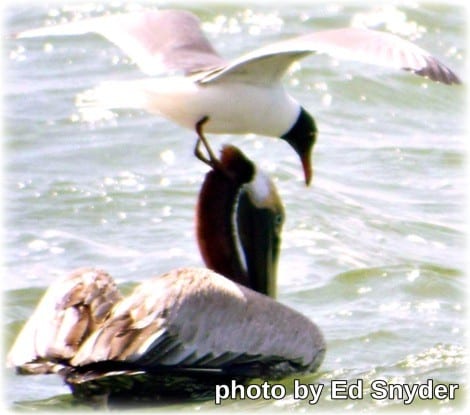 By Brenda Cannon Henley
By Brenda Cannon Henley
Watching all of God’s creatures do their thing, while on or near the water, I have learned so many interesting things. It is thrilling to get a bit of understanding as to how creation and creatures all work together for the common good. This education is so much more fun when one is seeing in reality what actually takes place. I asked my friend, Ed Snyder, about the subjects of this column, not too long before he became sick. Ed provided me with the amazing photograph he took.
I had never before seen seagulls traveling so closely with the big brown pelicans that dot our skies and sit on our piers, pilings, rocks and jetties. These much smaller seagulls would dive down toward the sitting pelicans, sit on their heads or backs, and seemingly steal fish and other food from the sides of the pelican’s big mouth or pouch. And the much bigger and stronger pelicans allowed it to happen over and over.

I mentioned this odd occurrence and an Examiner reader, Sherrie Roden, sent me some fun information. I found it fascinating and thought perhaps you would, too. Sherrie found the information in the St. John Beach Guide, Virgin Islands.
In the spring, laughing gulls return to St. John from the coast of Venezuela, where they habitually spend their winter vacations. While in the Virgin Islands, these bold and boisterous sea birds visit the less frequented offshore cays where they mate and lay their eggs. In addition to their breeding activities, the laughing gulls spend their time gathering food to eat, which can include fish and other seafood as well as just about anything that we humans decide to throw their way. One method the laughing gull has of getting food is to steal fish from another seabird that inhabits the region, the brown pelican. The laughing gull accomplishes this larceny by waiting for the brown pelican to make a successful dive.
When the pelican has a bill full of fish and water, it transfers the fish to the pouch that hangs below its bill. The pelican cannot fly away or swallow the fish until the water is drained from the pouch. Laughing gulls either circle closely above the pelican or land on the pelican’s bill or head. The gull may even give the pelican a sharp peck or two. If the pelican pays too much attention to the antics of the laughing gull and not enough attention to the delicate draining and swallowing process, the pelican may lose some of the trapped fish. The gull then swoops down and scoops up the pelican’s hard-earned catch, flying away at top speed from the scene of the crime and making short work of his ill-gotten gains.
There is a West Indian folk tale that deals with this phenomenon. Ranger Laurel Brannick of the Virgin Island National Park Service recently shared this story with me. The tale goes like this:
Once upon a time the pelican had a large body and a small bill, while the seagull had a small body and a large bill. Neither the pelican nor the seagull was happy with this state of affairs. The pelican could not catch enough fish with its small beak to satisfy the needs of such a large creature as himself, and the big bulky bill on the diminutive seagull only interfered with its ability to fly.
The two seabirds decided to remedy the situation by trading bills, the gull getting the small bill for its smaller body and the pelican getting the large bill, more suitable for its large body. The seagull, realizing that the pelican had more to gain from the trade, convinced the pelican to promise to share his presumably increased catch. The pelican agreed to give up half of its catch upon the demand of the seagull.
Immediately after the trade, the pelican tried out his new bill. He dove into the water and came up with a bill full of tasty fish. It was just as the pelican thought. He had become the best fisher of all the sea birds.
The pelican let the water slowly drain out of its beak. He tilted back his head to begin the art of eating, and lo and behold, the seagull demanded his share. He grabbed several fish and flew off to enjoy the trade.
I enjoyed the tale, whether it be tall or not, and made a point of observing the pelicans and gulls on Galveston Bay. I love their antics and it seems to be a wonderful, working partnership. Oh, that humans could share that well.
Brenda Cannon Henley can be reached at (409) 781-8788, or
[email protected]
[6-17-2019]

 Posted in
Posted in 
























While sitting in the cockpit of our sailboat in San Diego Bay, we observed what at first we thought was a mother pelican and her baby. Upon closer examination, we realized that the smaller bird was an immature seagull. We thought it odd that the seagull would jump onto the back of the pelican, but now we understand. Also, when the pelican took flight, the gull followed. This was repeated until they flew out of sight. You are correct that one can learn much about animal behavior by simply sitting quietly and observing.